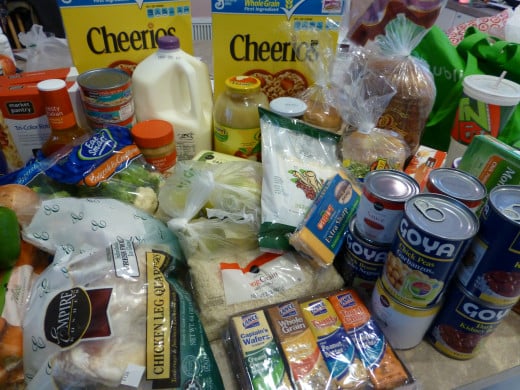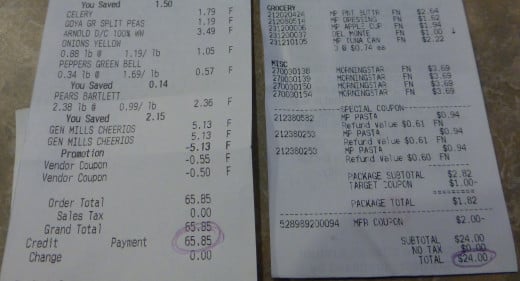Food Stamp Challenge

Can you feed your family on $1.44 per person per meal? That's what the average recipient of food stamps in the U.S. gets to supplement their family's food budget. As of June 2012, there were more then 46,000,000 people receiving food stamps, approximately 14% of the country.
Those of us who are blessed with adequate or even generous incomes can easily forget the hardships that our brethren of lesser means must undergo to take care of their families and themselves. Taking a week from our lives to try to feed our own families on the equivalent of food stamp benefits can help open our eyes to the sufferings of others, and hopefully make us more generous in helping others in need.
What Is the Food Stamp Challenge?
The food stamp challenge is exactly what it sounds like: a challenge for you to feed yourself and/or your family on the average amount of money needy people get for food stamp benefits for a week. The goal is to raise awareness of poverty and hunger in this country, and work towards eradicating them.
The rules are simple:
- You have a budget of $31.50 per person (of your own money) to buy a week's worth of food that adheres to SNAP (Supplemental Nutrition Assistance Program) guidelines.
- You can use the condiments in your fridge, but not the food already stocked in your pantry.
- You can pay for your children to eat school lunch out of a separate budget; the children of families on food stamps eat school lunch for free.
- If there are free refreshments available to you at a meeting or social gathering, you may partake; however, you cannot use your food stamp budget to eat in restaurants.
- Make a donation to an organization that fights hunger, such as a food pantry or soup kitchen. You can donate packaged food or money, but ideally you will give enough to cover the difference between the food stamp challenge and your regular weekly food budget.
The group you are doing the challenge with may have a debriefing session at the end for you to share your experiences. Hearing about others' experiences can be a very meaningful part of the challenge, so take the time to attend if possible.
What Can You Buy on Food Stamps?
The Supplemental Nutrition Assistance Program (SNAP is the official acronym, but the program is usually called food stamps) is designed to provide nutritious food for households. Therefore, certain items are not eligible to be bought with food stamp money. (These guidelines may not make perfect sense, but the government has determined for now that the administrative costs associated with prohibiting certain foods would be too high.)
You can buy:
- fresh food, such as fruits, vegetables, meats, fish, poultry, and dairy products
- processed foods, such as packaged breads, cereals, and grains
- "junk" food (e.g., soda, candy, or cookies)
- seeds and plants (with the intention of planting them for growing food)
You can't buy:
- ready-to-eat hot foods (e.g., rotisserie chicken from the deli counter)
- food that will be eaten in the store (e.g., lunch from the supermarket salad bar)
- alcohol or tobacco in any form
- non-food items, such as paper goods, pet food, or cosmetics
- vitamins or medicine

My Personal Experience With the Food Stamp Challenge
We chose to do the challenge with the Jewish Council for Public Affairs, which ran two weeklong challenge sessions in Fall 2012. Several national Jewish organizations signed on, including the United Synagogue of Conservative Judaism, which our synagogue is a member of. Since my husband is the rabbi of our synagogue, we decided that our family should take the challenge, and several families joined us.
Our family of four has a budget of $126 for the week. This is about 80% of our usual food budget. The children always eat lunch at school, which helps, and we ordinarily eat a light lunch at the synagogue on Saturday afternoon after services. I decided to plan our meals more carefully than usual, and base the meals around foods on sale, which I don't always do. We also keep kosher, so some foods are more expensive than non-kosher foods, but there's nothing we can do about that!
We stuck with basics as much as possible: Cheerios and milk for breakfast for all of us (the store was running a BOGO sale this week—score!) and leftovers and/or PBJ sandwiches for lunches. All of our planned dinners were standard dinners in our house: homemade pea soup, vegetarian chili, egg and bagel sandwiches, roast chicken, pasta salad, spaghetti with vegetarian chicken nuggets, and grilled cheese. I even stocked up on veggies, since fresh steam-in-bag broccoli was on sale for a dollar.
We did surprisingly well sticking to our budget; we got all the foods on our original list for just $89. As the week went on, we ended up spending the rest of the money as well (some on extras, like soda, and some on additional necessities, such as another loaf of bread and more milk). The hardest parts of this challenge were forgoing restaurants (we don't eat dinner out very often, but we do like to eat a quick lunch out a few times a week), skipping junk food snacks in favor of healthy, nutritious food, and boredom with our food options. Here are some notes from the week:
- Day 1: So far, so good. Delicious pea soup for dinner. I did give in and pick up some soda on sale, though.
- Day 2: We're eating more fruit without as much junk food in the house. That's good, except apparently I didn't buy enough.
- Day 3: Starting to get a little panicky; one giant box of Cheerios is already finished! Had a serious, high-level budget negotiation over the remaining $28. Additions to our fridge now include grapefruits, another loaf of bread, cottage cheese, and some pretzels. Just $10 left for the week.
- Day #4: Too much running around to think about food today; it's good to keep our mind off this challenge.
- Day #5: I'm seriously jonesing for a bean burrito. We have food in the house, so no one's going hungry, but we're not very happy with the restricted options we have, either.
- Day # 6: I cooked freezer burned chicken parts for dinner, since it was cheaper than the fresh chicken breasts I usually get. Our Shabbat dinner may not be as elegant as usual, but we'll have it nonetheless.
- Day #7: We ended the week with just a bit of Cheerios, half a loaf of bread, some peanut butter, and a few odds and ends left. This week really drove home the fact that plenty of people out there wouldn't have adequate nutrition if not for the SNAP program!
The Movie "Food Stamped" Chronicles A Couple's Attempts at Living on Food Stamps
How to Do Your Own Food Stamp Challenge
- Most food stamp challenges are sponsored by religious or charitable organizations; call your church or a local food pantry to see if they'd be interested in taking part.
- Set the dates and parameters of your challenge. The challenge we did was for $1.50 per person per meal, but there are other amounts suggested on various websites. The average food stamp benefit works out to $1.44 per meal.
- Get the word out. Tell your friends about it, put in on Facebook, and have your church's clergy make an announcement at services. The more people who do it together, the better you can share the lessons you've learned once it's over.
- Schedule a debriefing session for the end of the challenge. Spend some time talking with the participants about what they ate, the difficulties they faced, and how they feel about the food stamp program now.
- Arrange a fund-raising drive to coincide with the program. Ask participants to donate the difference between how much they usually spend on groceries and the amount they spent during the challenge. Local food pantries or national charities that fight hunger would be happy to receive your donations.
Example of a Family's Monthly Food Stamp Benefit
The Smith family has four members: two able-bodied working adults and two children.
- Ma and Pa Smith both work full-time minimum wage jobs and have a combined gross monthly income of $2,360.
- After applying the standard deductions, their monthly net income is $1,728.
- $1,733 x .3 = $518.40
- $668 is the maximum monthly benefit for a family of four; $668 - $519 = $149.
The Smith family is eligible to receive $149 per month in supplemental government food assistance.
What are the Requirements for Food Stamps?
People must meet certain requirements to qualify for food stamps. Although some of the requirements vary by state, generally recipients must:
- have resources of $2,000 or less (e.g., money in the bank), not including a home. The fair market value of a car worth less than $4,650 is also not counted in most states.
- have a gross monthly income that is less than 130% of the poverty line (e.g., $1,211 for a single person or $2,498 for a family of four) AND a net monthly income (gross income minus certain deductions) of 100% of the poverty line (e.g., $931 for a single person or $1,921 for a family of four).
- work or participate in certain employment programs, if they are able-bodied adults.
The rules are slightly different for the elderly and disabled.
The monthly allotment for a family varies based on household size and income. SNAP recipients are expected to spend 30% of their net income on food, so benefits are figured by multiplying a household's net income by .3, and then subtracting that number from the monthly maximum allotment. The result is a family's monthly benefit.








